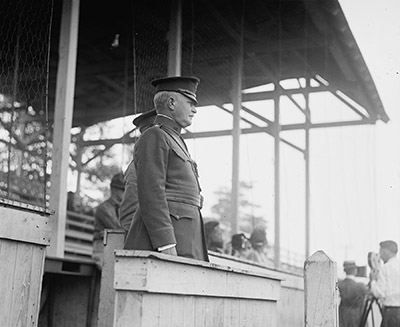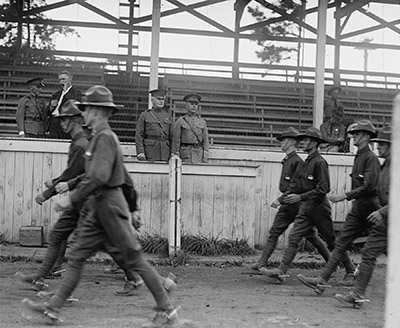PORTLAND, MULTNOMAH COUNTY; 1890s, 1900s, 1910s:
Martin was Oregon’s own would-be fascist dictator
Audio version: Download MP3 or use controls below:
|

Following the Boxer Rebellion, Martin returned to the states and served in various functions with great discipline and competence, much of it in the Portland area. In 1913, the Army lent him to the limping, ramshackle Oregon National Guard so that he might instill some proper military discipline into it; he did. In 1916 he was deployed to reinforce Gen. John Pershing in his operations against Pancho Villa in Mexico. And then the U.S. entered the First World War. Martin, by then a full-bird colonel, received a brevet (temporary) promotion to brigadier general and put in charge of training camps. It’s in this capacity that he earned the nickname “Iron pants.” His success in breaking down recruits to build them back up as soldiers led to Martin being given a particularly noteworthy assignment near the end of the war — an assignment that unquestionably represents the ugliest stain on his career and is equally unquestionably the most dishonorable and shameful official act ever undertaken by the United States Army. The military authorities had a problem that they wanted Martin's help with. It seemed that the African American soldiers who had signed up to go to France and fight had been treated as equals by the French, rather than as subhumans. Despite increasingly desperate attempts by white American officers to induce the French to adopt the proper attitude of arrogance and disdain toward them, the black doughboys were enjoying an unprecedented level of social freedom and acceptance. The worry was that they had gotten used to this, and would use their new status as war heroes to demand similar equality upon their return to the states. What was needed, according to military authorities, was a re-indoctrination clinic of sorts, under the guise of “training.” And who better to administer that training than old Iron Pants? Martin himself had no use for Black people, opining many times that they were inferior in every way to himself and his white friends, and was thoroughly on board with the plan to “put them back in their place.” Thus did Charles Henry Martin, future governor of the state of Oregon, become the central figure in the most shameful official act in American military history — the deliberate, systematic breaking of the spirit of an entire divisional cohort of American combat veterans and war heroes. The Black veterans were given the most degrading duties Martin could find for them, including cleaning out toilet pits, burying rotting corpses, and the kind of meaningless rock-breaking busywork one associates with prison chain gangs. They were worked all day and given no liberty to leave the camp. Meanwhile, Martin and his staff cultivated rumors back home that they had been running amok in France, raping French girls by the dozens, and Martin openly referred to them as the “rapist division.” It was hoped that this would prevent anyone from thanking them for their service, and thereby reminding them of their status as veterans. (An investigation later revealed that for the entire war, just two charges of rape were made against members of the division.) It is worth noting that Martin, after the war, blamed the low status of this “training” assignment for the fact that his temporary promotion to brigadier general was not made permanent after the war. Perhaps lingering resentment of that is why, after the war, Martin filed a report that would become the core of the U.S. Army’s policy on African American soldiers from the early 1920s until the early years of the Second World War. It was designed to minimize Blacks’ access to the kind of combat roles in which they might distinguish themselves as heroes, to avoid having Black officers over the rank of first lieutenant, and most of all to ensure that no white soldier or officer ever had to take an order from any Black man of any rank whatever. Martin’s Army career ended with his retirement in 1927. He left the Army a very different man than he had been when he entered it. A merciless disciplinarian with a worshipful attitude toward vested authority and a growing fear of communism, he was already starting to show signs of the Gen. Jack D. Ripper-style paranoia that his political career would reveal after his return to civilian life. We’ll talk about that political career in Part Two of this three-part story.
|
Background photo is a hand-tinted image of Tillamook Rock Light ("Terrible Tilly), published circa 1925 on a picture postcard.
Scroll sideways to move the article aside for a better view.
Looking for more?
On our Sortable Master Directory you can search by keywords, locations, or historical timeframes. Hover your mouse over the headlines to read the first few paragraphs (or a summary of the story) in a pop-up box.
... or ...

©2008-2016 by Finn J.D. John. Copyright assertion does not apply to assets that are in the public domain or are used by permission.

